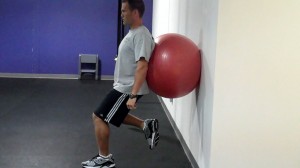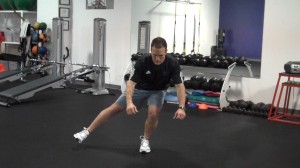Brian Schiff’s Blog
Injury Prevention, Sports Rehab & Performance Training Expert
If you have been following my blog, you are aware one of my marathoners has been battling increased medial knee pain. I initially suspected and diagnosed it as patello-femoral irritation. I have known she has some chondromalacia (softening or weakening of the cartilage behind the kneecap) ever since I began training her 2 years ago.
I spoke with the MD Thursday and he confirmed by MRI she has no meniscus tear and just patello-femoral arthritis and inflammation. I was relieved to know I had hit the mark (remember the chiro said meniscus tear). The MD I referred my client to wants me to do a specific PF strengthening program with her. The good news – no surgery needed that will derail training for the Columbus Marathon. The bad news – she may have to contend with some discomfort related to the pounding for now.
It is always hard to tell a runner to rest. That is one four letter word that really ticks them off! So, the answer for my client is relative rest (avoiding excess mileage, not running down too many hills, and increasing recovery windows when possible) as well as implementing a more specific PF rehab program.
We have been doing lots of quad (VMO specifically) work and gluteus medius strengthening already. So, what I will be adding or changing? Well, we will be integrating more repetitively the following:
- Weighted straight leg raises in flexion and adduction
- Modified box step-downs in the terminal range of knee extension to emphasize VMO contraction in a closed chain manner
- Modified lunge and squat progressions working around the pain
I will be continuing with single leg strengthening for glutes, hamstrings and quads, while challenging hip stability in the frontal plane as she may be experiencing unwanted force transmission here with impact. Additionally, I will continue with IT band rolling/stretching and hamstring flexibility.
This client is tough and will run through the pain if need be. My job is to reduce and eliminate the pain without taking her running away. That is never easy but it can be done with careful progression of exercise and cooperation from the client. The key point for strength and conditioning specialists is to modify programming based on the client, while the key point for all runners out there is to be open and honest about pain, as well as willing to comply with modifications in the short term training plan to achieve the same long term goal – finishing the race.
Below is a picture of a modified squat progression (an isometric single leg stability ball wall squat/sit). I use this exercise with athletes and runners with patello-femoral pain issues when they can’t squat due to pain. If you want to see exactly how to do this exercise, subscribe to PFP Magazine and read my online column, Functionally Fit, here. My newest column will be out next week and address double and single leg isometric squats for patello-femoral pain.

Shallow Single Leg Wall Sit
So, my client saw the orthopodic doctor I sent her to on Wednesday. He called me and said he felt it was primarily patello-femoral arthritis and some irritation of the medial retinaculum (fold of tissue along the inside portion fo the kneecap). When I pressed him about the mensicus (remember the chiro suspected this injury), he felt my client at 35 was young to have an attritional meniscus tear, but he did decide to get an MRI to be 100% sure she did not have a tear of the medial meniscus.
For now, the plan is to let her run and train with me while we await the results fo the MRI and progress training based upon her pain/symptoms. So, what are good exercises for PF pain in runners? Obviously, I focus a great deal on strengthening the hip musculature, particularly the gluteus medius, as well as the quads and hamstrings. Essentially, reducing the amount of pronation, valgus load at the knee, and IT Band tigthness is important for female runners.
Below is a list of a few key exercises I include in this particular marathoner’s routine with me:
- Single leg stiff-legged dead lifts
- Single leg squats with opposite leg hip/knee drive
- Lateral ankle band walks
- Single leg lateral reaches
- IT Band foam rolling
Note: It may be necessary to modify the range of motion on single leg squats based on pain or specific hot spots on the kneecap. In this case, I typically work above or below the pain zone. I included pictures of the lateral band walks and lateral reach below (these really target the gluteus medius).

Lateral Band Walk

Single Leg Lateral Reach
As I prepare to launch my new arthritis DVD to the general public on May 11, I wanted to give you an effective exercise (included in the actual program) using a simple box to improve quad strength. In this three part progression, you should begin with a 4 inch box. The order (easiest to hardest) is:
- Posterior box step-down – in this version you lower the whole foot or toe of the non support leg to the floor and then return to upright. As it gets easier attempt to only lightly touch down and reduce upper body support.
- Lateral box step-down – in this version you still keep the knee in line or behind the toes and lower the non support leg’s heel to the floor and then return to upright.
- Anterior box step-down – this is the hardest version because the weight shifts forward taking the knee over the toes (yes this is allowed in this case as it simulates descending stairs) and puts more emphasis on the quad muscle and less on the glutes and hamstrings. Again, lightly touch the heel to the ground.
In the video below, I will demonstrate how to do all three progressions with light upper body assistance. Once the knee is strong enough and pain free, eliminate upper body support completely as this will challenge proprioception and stability as well. Remember to work only in a pain free range of motion.
If you want to grab a copy of the arthritis DVD on sale, head over to www.fitknees.com as the price goes up on May 11 with the official launch.
Today, I am including a picture to better reveal the physical effects of pronation on the knee joint.

Now, in this photo of the right knee it points out ITB friction syndrome (runner’s knee). You can see how force is transmitted up the kinetic chain based on bio mechanical alignment. With increased internal tibial rotation, ITB irritation is a distinct possibility. In addition, it is important to note that this pronation also leads to increased valgus moments (knee caves inward) leading to added stress to the knee. It may also create increase shear force along the lateral patella and compressive force along the lateral knee joint.
This abnormal force transmission is one of the primary reasons runners with overpronation experience ITB and lateral knee pain. Aside from utilizing arch supports, getting proper footwear and gradually increasing mileage, there are some essential strengthening and stretching exercises to include if you have overpronation issues including:
- ITB stretching
- Hamstring and calf stretching
- Quadriceps strengthening
- Gluteus medius strengthening
- Single leg (knee bent) balance and reaching
- Single leg calf raises to increase arch support by strengthening the posterior tibialis
In the next post, I will review Chondromalacia (softening of the cartilage behind the kneecap) and patello-femoral arthritis, a condition that affects many women over the age of 30. I also wanted to let you know I will be releasing a DVD on knee arthritis in the next few weeks. If you read my blog, you will be entitled to a special pre-release offer as well. Stay tuned for more details.
Today, I begin a series on knee arthritis. Whether you simply want to do simple day to day things like get up out of a chair and walk up/down stairs or return to recreational sports without pain, you need tofirst understand how force (your own body weight) affects your knee. Over the next several posts, I will dive into this topic as I prepare to launch a new exercise DVD in my Fit Knees Series aimed at diminishing arthritic pain.

Severe Pronation



